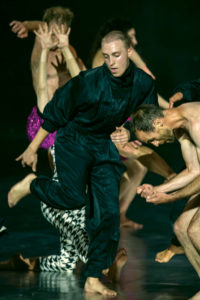Bolzano & Rovereto: Winter 2018 - Vancouver Ballet Society
- Home
- City Reports 2015 - 2019
- Bolzano & Rovereto: Winter 2018

by Silvia Poletti
Only 60 kilometres separate Bolzano from Rovereto, both located at the foot of the Dolomite Alps. Bolzano, a larger town, is lively, full of sparkling colours, with parks, water, mountains, palaces and markets all around. Various cultural influences — Indigenous Latin culture, German and Italian — add dynamic energy. Rovereto is a quiet town, so Italian that in the First World War many patriots lost their lives defending Italy’s freedom. An important museum devoted to the war is one of its attractions, although in recent years the Museum of Modern and Contemporary Art, or MART, has become a destination for European art-lovers.
Despite their differences, a common denominator in these towns is dance. In the second part of July, the Bolzano Danza Festival invades local stages, streets and museums, while in Rovereto, Italy’s oldest contemporary dance festival, Oriente Occidente, takes place every September.
Bolzano Danza shifted perspectives (physically) and viewpoints (intellectually) in experiments with different ways of conceiving dance. The influence of the early 1960s generation of American postmodern creators was strong. For example, Veduta (Views) by Italian Michele Di Stefano recalled an early experiment by Lucinda Childs, who gave instructions through a transistor radio to colleagues watching from studio windows as she performed in urban traffic. In Veduta, spectators guided into a building are humorously misled by the dialogue heard through wireless headsets — it seems that a fugitive is rushing through the Bolzano streets, who we follow to the big hall of the palace, to the principal town square and so on. Mission Impossible-type movie music sharpened the illusion of urgency.
Another perspective was offered by Italian Alessandro Sciarroni, whose unstoppable whirling on the spot (lasting 50 minutes or more) in Don’t be frightened of turning the page brought us closer to understanding mystical ecstasy or the hypnotic magic of perpetual motion, a feeling helped by the enchanting circular stone wine cellar where the show took place.
Bolzano Danza had hits with two very different shows. In 10,000 Gestures, French choreographer Boris Charmatz experimented with the idea of having each dancer compose their own score of 10,000 original movements, with no repetitions. What helped the artists to not repeat themselves was the different emphasis, tempo and direction they took, as well as their emotional intent and attack. This motley crew, in a hodgepodge selection of costumes, seemed to be anarchically expressing itself, each member isolated in his or her own set of gestures. Yet, as the piece progressed, with Mozart’s Requiem playing in the background, one could clearly see the vision of a true choreographer, who breaks down the idea of composition, but has the bigger picture in mind. This comes through in the way Charmatz controls the waves of movement and intersperses them with still, weighty images, and how he measures out the emotional tension and regulates the groups.
A totally different piece — and the other hit — was the light-hearted mixed bill by Canadian Eric Gauthier’s Stuttgart-based company, which presented a wide range of styles from Ohad Naharin, Marco Goecke, Virginie Brunelle and Gauthier himself. Gauthier’s piece, created with a little help from Andonis Foniadakis, was Electric Life, which was dedicated to Montreal’s Louise Lecavalier, a dancer who had impressed Gauthier in his youth for her incredible stamina and power, energy and dynamics. He recreated those here, including her famous whirling turns and dazzling jumps performed with devouring appetite by the company’s women.
Rovereto opened the 38th edition of its Oriente Occidente Dance Festival with three world premieres. Swedish choreographer and videomaker Pontus Lidberg created a dreamy atmosphere in Siren, thanks to a foggy light design wrapping the stage, with seven men and an exotic beauty dressed in green — the Siren of the title — searching for human contact. Its agreeable, clear dance vocabulary had a romantic touch that evoked neoclassical ballet memories (in the duet for the man and the Siren) and gave a clear choreographic telling of the narrative.
Not so for the two Italian premieres, whose choreographers’ starting points for their creations were two pillars of art: Shakespeare’s A Midsummer Night’s Dream for Davide Valrosso’s Sogno (Dream) and 1881 Italian ballet classic Ballo Excelsior for Salvo Lombardo’s Excelsior. The problem for both is that the references need to be somehow evident in the choreography in order for the audience to understand their new dramatic vision. Although gracious and fresh — thanks to the young dancers of Balletto di Roma — Valrosso’s Sogno remained superficial, and was limited to showing fluid human chains moving up and down the stage and shaping different combinations of partnerships.
Lombardo used the extravagant and historic Ballo Excelsior that celebrated human progress and discoveries to underline the oppression over a great part of humanity by a few — a heated subject, considering current world events. Unfortunately, in the new Excelsior, performed by Chiasma company, there was a poverty of choreographic language and simplicities such as having an Indian performer wear U.K. flag underwear. There needs to be a better balance between the choreographer’s intentions and the ability to find an efficient expressive vocabulary able to communicate them clearly to the audience.

Photo: Andrea Macchia
